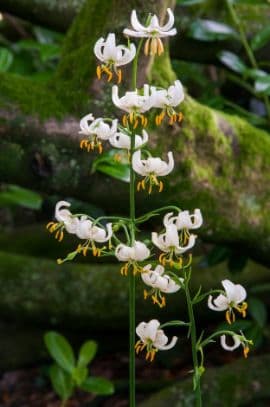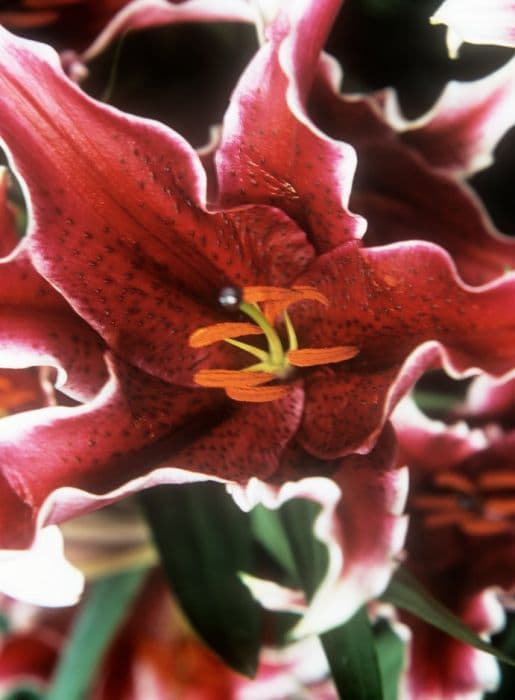Twinflowered tulip Tulipa biflora (15)

ABOUT
Twinflower tulip is a perennial plant renowned for its striking and elegant flowers. The blooms are typically white or pale yellow with a delicate, sometimes slightly blushing exterior. Each flower consists of six petal-like segments, which are arranged in a characteristic tulip shape, forming a cup or goblet-like appearance. Inside, the flower may showcase a different hue or pattern, often with a contrasting center, which adds to its visual appeal. The leaves of the twinflower tulip are slender, elongated, and usually a vibrant green, creating a beautiful contrast with the bright blooms. These leaves often have a smooth texture and appear glossy, emerging from the base of the stem and providing a lush, green backdrop for the flowers. Overall, the twinflower tulip is a charming and visually appealing plant that captures the essence of spring with its lovely blossoms.
About this plant
 Names
NamesFamily
Liliaceae
Synonyms
Twinflowered Tulip, Two-Flowered Tulip, Bifloral Tulip, Early Tulip, Mountain Tulip
Common names
Tulipa lehmanniana, Tulipa suaveolens, Tulipa uniflora, Tulipa orithyia, Tulipa biebersteiniana, Tulipa silvestris, Tulipa ucrainica, Tulipa polychroma, Tulipa montana, Tulipa undulatifolia, Tulipa sylvestris, Tulipa lanata, Tulipa tarda, Tulipa turkestanica, Tulipa bifloriformis.
 Toxicity
ToxicityTo humans
The Tulipa biflora, commonly known as the twinflower tulip, is not considered highly toxic to humans. However, like other members of the Tulipa genus, it contains compounds that can be irritating and may cause mild discomfort if ingested. Eating parts of the plant, especially the bulb, could potentially result in symptoms such as nausea, vomiting, and diarrhea. In some cases, contact with the sap may cause skin irritation or an allergic reaction. Ingesting large quantities of the plant is generally not advised due to the risk of gastrointestinal upset.
To pets
The twinflower tulip, or Tulipa biflora, is toxic to pets, particularly to cats and dogs. If ingested, the bulb is the most toxic part, but all parts of the plant contain compounds that can be harmful. Symptoms of tulip poisoning in pets may include vomiting, diarrhea, drooling, and lethargy. In severe cases, ingestion could lead to depression of the central nervous system, difficulty breathing, and an increase in heart rate. If you suspect your pet has ingested any part of this plant, contact your veterinarian immediately.
 Characteristics
CharacteristicsLife cycle
Perennials
Foliage type
Deciduous
Color of leaves
Green
Flower color
White
Height
6 inches (15 cm)
Spread
3 inches (7.5 cm)
Plant type
Bulb
Hardiness zones
3
Native area
Central Asia
Benefits
 General Benefits
General Benefits- Aesthetic Appeal: Tulipa biflora, commonly known as twinflower tulip, adds beauty to gardens and landscapes with its delicate white flowers and attractive shape.
- Seasonal Interest: Twinflower tulip blooms in early spring, providing one of the first bursts of color after winter, offering a cheerful sight to gardeners and visitors.
- Pollinator Attraction: The flowers of the twinflower tulip attract bees and other pollinators, contributing to the health of pollinator populations and supporting biodiversity.
- Low Maintenance: Twinflower tulip generally requires minimal care, making it a good choice for gardeners seeking plants that do not demand constant attention.
- Cultural Symbolism: Tulips, including the twinflower variety, have significant cultural and historical importance in many societies, often symbolizing love and the arrival of spring.
- Bulb Propagation: Twinflower tulip can be propagated easily through its bulbs, allowing gardeners to spread and share the plant with ease.
- Garden Design Flexibility: Its small size and ability to naturalize make twinflower tulip a versatile choice for rock gardens, border fronts, and container planting.
- Hardiness: Adapted to survive colder climates, twinflower tulip is a hardy plant that can withstand frost and return year after year in the right conditions.
- Educational Interest: Twinflower tulip can be used as a teaching tool in educational settings to demonstrate plant growth, reproduction, and horticultural practices.
- Celebration of Seasonal Change: The consistent annual blooming of the twinflower tulip is a symbol of the reliability of the seasons and is often celebrated in festivals and floral displays.
 Medical Properties
Medical PropertiesThis plant is not used for medical purposes.
 Air-purifying Qualities
Air-purifying QualitiesThis plant is not specifically known for air purifying qualities.
 Other Uses
Other Uses- The bulbs of Tulipa biflora, typically known as wild tulip, can be used as a food source; in times of scarcity, they have been cooked and eaten, similarly to how one might consume onions or potatoes.
- Wild tulip bulbs can serve as a starch substitute in gluten-free cooking, offering an alternative for those with wheat allergies or celiac disease.
- The petals of wild tulips may be used for natural dyeing, providing a range of colors from yellow to green, depending on the mordant used.
- Educational tools for botanical studies, as Tulipa biflora exhibits certain genetic traits and characteristics valuable for teaching genetics and plant biology.
- The flowers of wild tulips are sometimes used in perfumery for their delicate scent, contributing to floral arrangements, potpourri, or homemade natural fragrances.
- Crafting eco-friendly dyes for art projects, Tulipa biflora's vivid colors can be harnessed for creative use in fabrics and papers.
- Landscape gardening, using wild tulip to create naturalistic garden designs that are low maintenance and support local biodiversity.
- Wild tulips can act as indicator species in ecological studies, where their presence and health can signify the condition of their environment.
- As a motif in cultural artwork and design, Tulipa biflora often features in local crafts, textiles, and folklore for its aesthetic appeal.
- Tulipa biflora can be cultivated for educational purposes in schools and community gardens to teach children about plant life cycles and the importance of biodiversity.
Interesting Facts
 Feng Shui
Feng ShuiThe Tulip is not used in Feng Shui practice.
 Zodiac Sign Compitability
Zodiac Sign CompitabilityThe Tulip is not used in astrology practice.
 Plant Symbolism
Plant Symbolism- Perfect Love: Tulips, in general, represent perfect love, with certain colors symbolizing different aspects of love.
- Rebirth: As spring-blooming flowers, tulips symbolize rebirth and the coming of spring.
- Forgiveness: Tulips can also represent a request for forgiveness or an apology, as they embody the idea of renewal and setting things right.
- Ostentation and showiness: Because of their historical associations with the Dutch Tulip Mania and their obvious beauty, tulips may symbolize showiness or high value.
 Water
WaterTwinflower tulips should be watered deeply when the top inch of the soil feels dry to the touch; this often translates to roughly once a week during the growing season. Depending on various factors like humidity, temperature, and soil type, the watering frequency might need adjustment. Typically, you'll give them about one gallon of water per square yard each time you water. Ensure the soil has good drainage to prevent waterlogging as these plants do not tolerate soggy roots well.
 Light
LightTwinflower tulips thrive in full sun to partial shade. The best spot for these tulips is an area where they receive at least six hours of direct sunlight daily. However, in regions with hot climates, they benefit from some afternoon shade to protect them from the intense heat.
 Temperature
TemperatureTwinflower tulips prefer temperate climates and perform best in temperatures ranging between 60°F and 70°F. They can endure minimum temperatures down to around 20°F and maximum temperatures up to about 75°F. Avoid planting in areas where temperatures might exceed these limits for extended periods, as extreme temperatures can stress the plants.
 Pruning
PruningPruning twinflower tulips isn't necessary for the health of the plant, but deadheading spent flowers can encourage more vigorous growth and prevent seed formation. Trim off the faded blooms shortly after they fade, but leave the foliage in place until it turns yellow and dies back naturally. The best time for this minimal pruning is late spring to early summer, after the blooming period.
 Cleaning
CleaningAs needed
 Soil
SoilTwinflower tulips thrive best in neutral to slightly acidic soil with a pH range of 6.0 to 7.0. A well-draining soil mix with added sand or perlite and compost or well-rotted organic matter is ideal for fostering healthy growth and flowering. Ensure the soil remains moderately moist, but never soggy, to prevent bulb rot.
 Repotting
RepottingTwinflower tulips typically do not require frequent repotting and are often replanted annually. Once the foliage has died back after flowering, the bulbs can be lifted, stored in a cool, dry place during summer dormancy, and replanted in the fall for next season's bloom.
 Humidity & Misting
Humidity & MistingTwinflower tulips prefer moderate humidity levels and do not require high humidity to thrive. They are adaptable to the average outdoor humidity in most temperate climates where they are cultivated.
 Suitable locations
Suitable locationsIndoor
Place twinflower tulips in bright, indirect light and cool temps.
Outdoor
Plant in well-drained soil with full sun to partial shade.
Hardiness zone
3-8 USDA
 Life cycle
Life cycleTulipa biflora, commonly known as twinflower tulip, begins its life cycle as a bulb planted in the soil during dormancy, which typically occurs in the fall. The bulb undergoes vernalization through the cold winter months, which is crucial for the initiation of growth in the spring. As temperatures rise, the bulb sprouts, giving rise to leaves and a stem that supports one to two flowers per stem by late spring. The flowers bloom, displaying white or pale yellow petals, and are dependent on pollinators such as bees for cross-pollination. After pollination, the flowers develop into capsules containing seeds, which disperse when the capsule dries and splits open. The plant then enters a period of senescence, with the aerial parts dying back, and the bulb lying dormant underground until the next growth cycle is initiated.
 Propogation
PropogationPropogation time
Spring
Propogation: The most popular method of propagation for Tulipa biflora, commonly known as twinflower tulip, is through its bulbs. Propagation time is best in the fall, after the bulbs have completed their summer dormancy. Gardeners should plant the bulbs about 4 to 6 inches (10 to 15 centimeters) deep and around 4 to 5 inches (10 to 13 centimeters) apart in well-drained soil with good sunlight exposure. As the plant blooms and goes dormant in the summer, the bulbs will naturally multiply underground. The following fall, these bulbs can be dug up, separated, and replanted to propagate new plants. This method leverages the tulip's natural reproductive cycle, making it straightforward and effective for gardeners to expand their twinflower tulip displays.





![Lily [Roselily Chelsea]](/_next/image?url=https%3A%2F%2Fplants-admin.emdemapps.com%2Fimages%2Fplants%2F%2Fimages%2F604b584f6f830.png&w=640&q=75)



